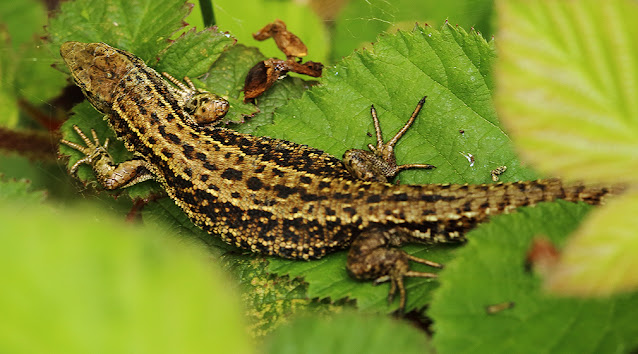Yes, a visit to Denge Wood; this from their website: Part of the ancient semi-natural woodland complex known as Denge Wood on the North Downs, Denge and Pennypot Wood is home to many invertebrates including the rare Duke of Burgundy butterfly. Lady orchids also flower here in summer.
I wish I could tell you that I had seen and photographed the rare Duke of Burgundy butterflies on my visit, but sadly, I didn't come close to even spotting one, despite locating the most likely areas. Even so, there were plenty of other invertebrates to keep me interested.
Beginning with this large beetle that I saw almost immediately...
I don't find these Chrysomelid beetle much locally, and so I'm not particularly au fait with them, but I think this one is probably Chrysolina hyperici. They seem to be associated with St John's Wort, and I am pretty sure that is where I found mine.Followed swiftly by what I at first sight thought must be Lagria hirta (Tenebrionidae ), but then on closer inspection, perhaps the legs are a bit pale, and it did seem a tad small for that particular beetle. I'm not doing too well with identity skills thus far am I: I'll try to improve if I can.
Edit: Thanks to Maria Justamond for identity information on this tiny beetle: Cerambycidae, Tetrops sp. Most likely praeustus, though there is the rarer starkii too!
Ah! Now I do know this next one. Cicindela campestris, the Green Tiger Beetle. Yes, I know, it's not tiger coloured: neither is it stripped, but spotted. What it is though, is a ferocious and agile predator. I spotted this one on a sandy path in the woods. Well, when I say I spotted it, it was already spotted if you see what I mean.
The green tiger beetle hunts spiders, ants and caterpillars on heaths, grasslands and sand dunes. It is one of our fastest insects. I think that is the association with tiger.
A Red-and-black Froghopper - Cercopis vulnerata was my next find. Actually, there were two in the same spot. This is an unmistakeable species. Even inspector Clouseau would be confident with this one. The nymphs of this species are rarely seen though, because people rarely see them! (Joke)...almost!
Stenodema species are elongate grass bugs. This one is Stenodema laevigata. They are a common species here in the UK.
The picture wing flies (pictured below) are principally identified from their wing patterns which give most species a distinctive appearance; apparently! These are going to be easy to identify then eh JJ?
Oh ha, ha...very funny! Okay, I haven't plumped for a while, and so I'll have a plump at Chaetorellia species.
(Plump and guess are semantically related. In some cases, you can use "Plump" instead of "Guess") Thesaurus says so!
Now I do know this one: only too well as it happens, because I have these in my own garden. The Woundwort Shieldbug (Eysarcoris venustissimus) is a member of the Pentatomidae family of insects. They are quite small, typically between 5 and 8mm in length but can sometimes be spotted glistening on nettles and woundwort plants on sunny days.
Senseless plant bugs, are a family of true bugs. Wait a jolly-old moment here. They are NOT Senseless bugs JJ! They are Scentless bugs.
Oh well, we all make mistakes. We do wrong things. We say wrong things. We fall, we get up. We learn. We grow. We move on. Perfection is the preserve of the pedant!
Where was I? Oh yes, Scentless bugs: I prefer to use the term Rhopalid bug myself, for that is what this is. Rhopalus subrufus, or R. parumpunctatus maybe? It is too dirty for me to be sure.
Edit: Thanks once again to Maria J. (Who has better eyesight than me) I can now reveal that this is indeed "R. subrufus, as whilst it is mucky, you can see the bifid tip to the scutellum".
---------------------------------------------
What a treat this was. I don't have the habitat locally for this species of butterfly, and so I was pleased to spot a couple at Denge.
I cribbed the following info from the Butterfly Conservation website: The Small Heath is an inconspicuous butterfly that flies only in sunshine and rarely settles more than a metre above the ground. Its wings are always kept closed when at rest.
The underside of the forewing has an eyespot at the tip. Hindwing banded with brown, grey and cream. The number of broods and the flight periods are variable and adults may be seen continuously from late April to September on some sites in southern England.
From a butterfly to a moth. The Cinnabar - Tyria jacobaeae. Again, I don't see these all that often. When I do, they are normally a good deal redder than this one, which seems to be closer in colour to the larvae, which are orange and black. Those I do see a lot of, on the ragwort plants.








.jpg)















2 comments:
Hey JJ!
Hope all's well! Your little 'furry' beetle is Cerambycidae, Tetrops sp. Most likely praeustus, though there is the rarer starkii too! The Rhopalid is R. subrufus, as whilst it is mucky, you can see the bifid tip to the scutellum. Brilliant blog update as ever! Denge Wood looks a lovely place to explore.
Mx
Hey! Maria ;-)
Thanks so much! Yes, all good here thanks. I'll update that tiny beetle and regards the R. subrufus...NO...YOU can see the scutellum detail - this boy cannot ;-) Anyhow, I will update that also. Many thanks for giving your time to visit and leave these comments.
Post a Comment